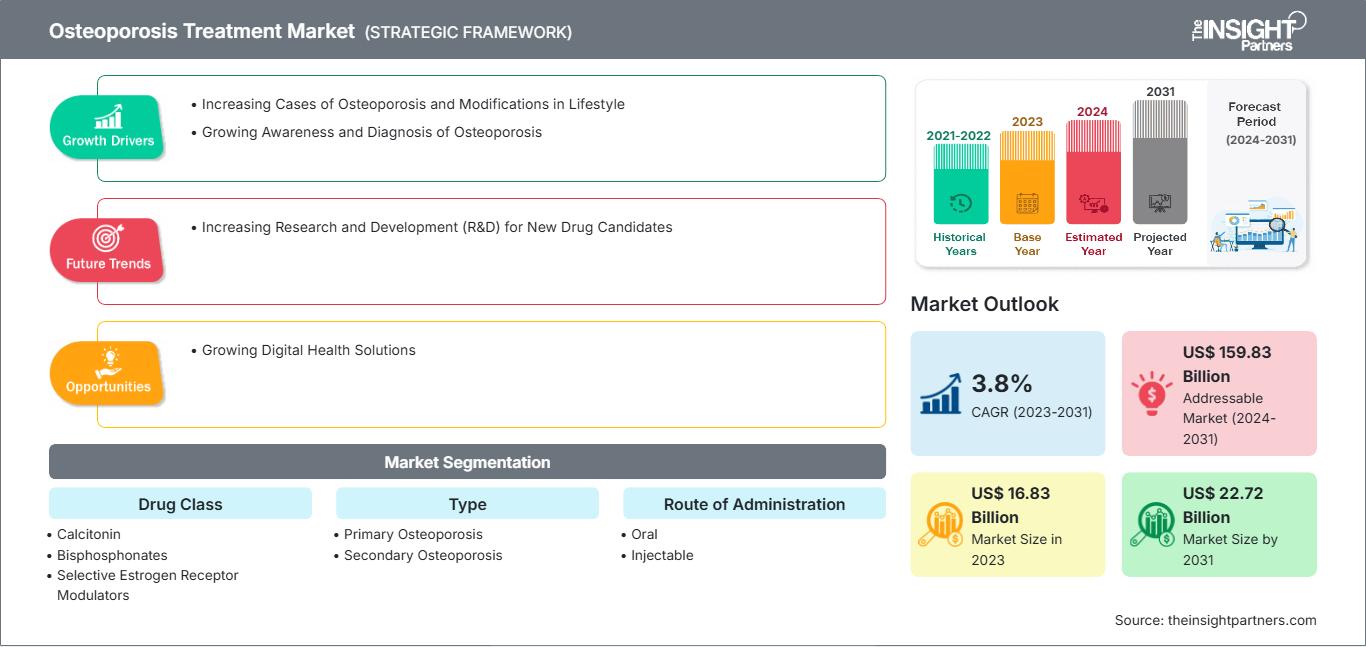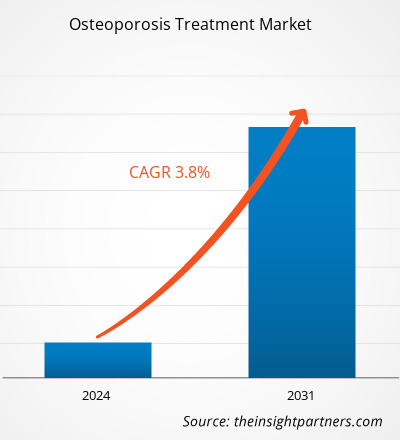预计骨质疏松症治疗市场规模将从 2023 年的 168.3 亿美元飙升至 2031 年的 227.2 亿美元;预计该市场在 2023 年至 2031 年期间的复合年增长率为 3.8%。分析师观点:
本报告涵盖了当前骨质疏松症治疗市场趋势及其在预测期内可预见的影响所带来的增长前景。骨质疏松症会导致骨骼变脆,轻微跌倒就可能导致骨折,从而影响生活质量。早期发现和治疗有助于减缓甚至阻止骨质疏松症的进展,进而降低骨折风险。因此,骨质疏松症的患病率增加了诊断的需求,从而促进了骨质疏松症治疗市场的增长。骨质疏松症主要见于女性,这是由于更年期激素变化会影响骨密度所致。除了激素变化外,类风湿性关节炎、骨质疏松症家族史以及长期服用影响骨骼强度的药物也会增加老年人患骨质疏松症的风险。根据国际骨质疏松症基金会的数据,在大多数骨质疏松症患者中,25% 为女性,5% 为 65 岁以上的男性。
市场概览:
骨质疏松症是一种进行性疾病,与男性、绝经后女性和老年人群的高风险骨折有关。骨质疏松症患者尤其容易发生骨骼、髋部、前臂、脊柱和腕部骨折。因此,它被描述为一种代谢性疾病,会降低骨矿物质密度并导致骨折。治疗手段通常包括双膦酸盐、激素疗法、地诺单抗和一系列营养补充剂,并建议调整生活方式,例如增加体育锻炼和富含钙的饮食。推动骨质疏松症治疗市场增长的关键因素包括医疗保健在药物研发上的支出增加,以及人们对可用于治疗骨质疏松症的药物的认识提高。
自定义此报告以满足您的要求
您将免费获得任何报告的定制,包括本报告的部分内容,或国家级分析、Excel 数据包,以及为初创企业和大学提供超值优惠和折扣
骨质疏松症治疗市场: 战略洞察

-
获取本报告的主要市场趋势。这个免费样本将包括数据分析,从市场趋势到估计和预测。
全球范围内,骨质疏松症的患病率正在上升,这主要是由于不良的生活方式、不良的饮食习惯、缺乏运动、钙和维生素D摄入不足以及激素失衡。根据国际骨质疏松症基金会的数据,每年有超过890万例骨折是由骨质疏松症引起的,平均每三秒就会发生一起骨质疏松性骨折,据估计,全球有2亿女性受到影响。老年人口的增加也是推动骨质疏松症治疗市场增长的重要因素。根据发表在Labiotech上的一项名为《骨质疏松症研究进展》的研究,约有1000万美国人患有骨质疏松症。约4400万人骨密度低,这使他们患骨质疏松症的风险增加。患骨质疏松症的风险随着年龄的增长而显著增加;据估计,50岁及以上的成年人骨折风险较高。在美国,每年遭受髋部骨折的65岁及以上成年人中,四分之三是女性,据估计,约有15%至36%的髋部骨折患者在一年内死亡。对整体健康和保健的更广泛重视鼓励人们定期进行健康筛查,包括骨密度扫描。随着人们积极主动地监测骨骼健康,早期诊断和干预变得越来越重要,这进一步刺激了市场的扩张。随着人们对骨骼健康的认识不断提高,骨质疏松症治疗市场正获得巨大推动,这推动了对预防和治疗解决方案的需求。
细分分析:
骨质疏松症治疗市场分析基于以下细分:药物类别、类型、给药途径和分销渠道。
根据药物类别,骨质疏松症治疗市场细分为RANKL、双膦酸盐、选择性雌激素受体调节剂 (SERM)、激素疗法等。 RANKL 细分市场在 2023 年占据最大市场份额。然而,激素疗法细分市场预计在 2023 年至 2031 年期间的复合年增长率最高。双膦酸盐细分市场在骨质疏松症治疗市场中也占有相当大的份额。双膦酸盐,包括阿仑膦酸盐和唑来膦酸等化合物,已被证明可有效抑制骨吸收、增加骨密度并最大限度地降低骨折风险。其丰富的临床应用、监管部门的批准以及口服和静脉注射剂型的普及,使其成为医疗保健专业人士的首选。此外,其成本效益和全面的保险覆盖范围也使其在骨质疏松症治疗市场中得到广泛采用。
根据骨质疏松症的类型,市场分为原发性骨质疏松症和继发性骨质疏松症。原发性骨质疏松症细分市场在 2023 年占据了较大的骨质疏松症治疗市场份额。原发性骨质疏松症伴随衰老而发生,导致骨骼更新缓慢。根据美国国家医学图书馆发表的一项题为“绝经后女性原发性骨质疏松症和低骨量患病率及相关风险因素”的研究,全球30%的50岁以上女性患有骨质疏松症。每年8%至9%的骨折已知是由骨质疏松症引起的。此外,70岁及以上的男性和女性会经历骨形成和骨丢失之间的不平衡,导致背痛、生活质量下降和日常活动能力下降。
根据给药途径,骨质疏松症治疗市场分为口服和注射两类。注射剂在2023年占据了骨质疏松症治疗市场的最大份额。预计注射剂在2023年至2031年期间的复合年增长率最高。注射剂在市场中的主导地位可以归因于其作为给药方式的有效性和可靠性。通过注射给药可确保药物直接进入血液,从而实现快速且可预测的吸收,这是治疗骨质疏松症的关键优势。此外,某些骨质疏松症药物仅以注射剂型提供,这进一步提升了其市场份额。随着患者对自行注射的依从性不断提高以及创新药物输送解决方案的不断发展,注射剂市场有望保持其强劲的市场地位。
区域分析:
骨质疏松症治疗市场报告的范围包括北美、欧洲、亚太地区、中东和非洲以及南美洲和中美洲。北美市场在 2023 年的价值为 82.6 亿美元,预计到 2031 年将达到 112.6 亿美元;预计 2023 年至 2031 年期间的复合年增长率为 3.9%。推动该地区市场增长的关键因素之一是该地区人口老龄化显著,人们对骨质疏松症的认识也更加深入。其次,先进的医疗基础设施和全面的医疗服务使人们能够及时诊断和治疗。此外,大型制药公司的存在和持续的研发计划也鼓励创新疗法的引入。最后,优惠的报销政策和保险覆盖为寻求骨质疏松症治疗的患者提供支持,促进了北美骨质疏松症治疗市场的发展。
亚太地区骨质疏松症治疗市场预计将录得最高的复合年增长率,达到4.7%。该地区,尤其是印度和中国等国家,拥有规模庞大的制药产业。中国是制药制造中心。该地区预计的市场增长归因于中产阶级的壮大和医疗保健可及性的提高。此外,医疗基础设施的改善和新兴的制药行业使亚太地区成为骨质疏松症治疗市场显著增长和发展的枢纽。
骨质疏松症治疗市场区域洞察
The Insight Partners 的分析师已详尽阐述了预测期内影响骨质疏松症治疗市场的区域趋势和因素。本节还讨论了北美、欧洲、亚太地区、中东和非洲以及南美和中美洲的骨质疏松症治疗市场细分和地域分布。
骨质疏松症治疗市场报告范围
| 报告属性 | 细节 |
|---|---|
| 市场规模 2023 | US$ 16.83 Billion |
| 市场规模 2031 | US$ 22.72 Billion |
| 全球复合年增长率 (2023 - 2031) | 3.8% |
| 历史数据 | 2021-2022 |
| 预测期 | 2024-2031 |
| 涵盖的领域 |
By 药物类别
|
| 覆盖地区和国家 |
北美
|
| 市场领导者和主要公司简介 |
|
骨质疏松症治疗市场参与者密度:了解其对业务动态的影响
骨质疏松症治疗市场正在快速增长,这得益于终端用户需求的不断增长,而这些需求的驱动因素包括消费者偏好的转变、技术进步以及对产品益处的认知度的提升。随着需求的增长,企业正在扩展产品线,不断创新以满足消费者需求,并抓住新兴趋势,从而进一步推动市场增长。

- 获取 骨质疏松症治疗市场 主要参与者概述
辉瑞公司、安进公司、卡迪拉制药、礼来公司、第一三共株式会社、梯瓦制药公司、旭化成株式会社、诺华公司、中外制药株式会社和帝人制药有限公司是骨质疏松症治疗市场报告中介绍的主要参与者。
最新发展:
在骨质疏松症治疗市场运营的公司采用并购作为关键增长战略。根据公司新闻稿,以下列出了一些最新的市场发展:
- 2021 年 10 月,领先的生物技术公司 Entera Bio 发布了其中期口服骨质疏松症药物配方研究的关键数据。该公司已推进该研究的 3 期注册。
- 2021 年 8 月,印度药品管理总局 (DCGI) 向 Enzene Biosciences Ltd 颁发了生物仿制药 Denosumab 的上市许可 (MA),该药物用于治疗成人骨质疏松症。
- 2021 年 1 月,总部位于伦敦的制药公司 Theramex 在欧洲推出了骨质疏松症药物 Livogiva。
- 历史分析(2 年)、基准年、预测(7 年)及复合年增长率
- PEST和SWOT分析
- 市场规模、价值/数量 - 全球、区域、国家
- 行业和竞争格局
- Excel 数据集
近期报告
客户评价
购买理由
- 明智的决策
- 了解市场动态
- 竞争分析
- 客户洞察
- 市场预测
- 风险规避
- 战略规划
- 投资论证
- 识别新兴市场
- 优化营销策略
- 提升运营效率
- 顺应监管趋势






















 获取免费样品 - 骨质疏松症治疗市场
获取免费样品 - 骨质疏松症治疗市场